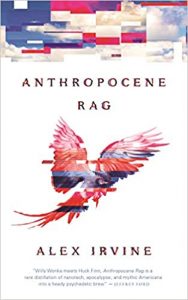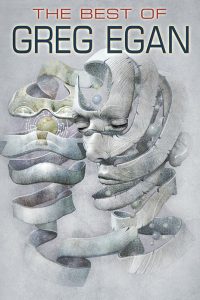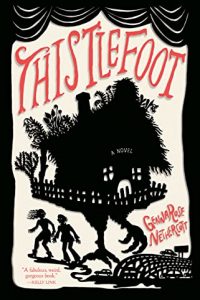Adrienne Martini Reviews Anthropocene Rag by Alex Irvine
 Anthropocene Rag, Alex Irvine (Tor.com Publishing 978-1-250-26927-0, $14.99, 256pp, tp) March 2020.
Anthropocene Rag, Alex Irvine (Tor.com Publishing 978-1-250-26927-0, $14.99, 256pp, tp) March 2020.
I’m still not certain what actually happened in Alex Irvine’s Anthropocene Rag – but I do know that this journey into the heart of a transformed-by-nanotech America is a fascinating ride to take. In the end, that may be all that matters.
Irvine’s America is one where the Boom – essentially, programmable bits of tech that are omnipresent and unpredictable – has happened, thanks to an eccentric billionaire. Sort of. It’s complicated.
Said billionaire has built Monument City, which is where he moved all of the world’s physical icons, like the pyramids or the Taj Mahal. Life-7, the intelligence behind the Boom (again, sort of. Things are weird.) sends out an emissary to deliver six invitations to carbon-based humans, Wonka-style. The story follows those chosen ones as they travel through the dreamscape this country now is to get to Monument City.
The big problem with living in a post-Boom world is that the Boom only wants to recreate the stories our culture tells itself about itself, even if the retelling leads to mass death. Some of the Boom’s creations are amusing, like in San Francisco, where dozens of Emperor Nortons wander the streets, each one insistent on playing out what the legends of the man said he did. Mark Twain is a riverboat captain here, and Paul Bunyan makes a cameo. It is a world of fable, real story, and myth, all mushed together.
The problems arise when the Boom gets confused about what the story is or how to recover if reality doesn’t match what it anticipates. That’s when real-life people get hurt or disappeared or turned into bison. The technology is capricious and the consequences can be fatal.
Our chosen six are our guides to this new world. It’s a quest story, yes, but it also shares DNA with Fear and Loathing in Las Vegas, The Wizard of Oz, and, maybe, Rango. The journey is all.
And the journey is a wonder – but where Irvine shines is when he tries to get his arms around deeper ideas about what story is and why it is important to who we are. He doesn’t come at that head-on but, rather, sideways and through the margins. The reader’s understanding accretes rather than arrives.
Take, for example, this bit about the idea of who is in the story and who is not. The protagonists only focus on themselves.
The narcissism of the lucky. They all have stories, those ordinary people, but they are not our story. Don’t worry, there are still bored office workers and striving parents and joyful children and pragmatic bureaucrats. Also petty criminals and cynical cops and bank tellers and soccer coaches. In a disaster, life goes on.
The stories are what keep life going on in Anthropocene Rag. I think, anyway.
Adrienne Martini has been reading or writing about science fiction for decades and has had two non-fiction, non-genre books published by Simon and Schuster. She lives in Upstate New York with one husband, two kids, and one corgi. She also runs a lot.
This review and more like it in the December 2020 issue of Locus.
 While you are here, please take a moment to support Locus with a one-time or recurring donation. We rely on reader donations to keep the magazine and site going, and would like to keep the site paywall free, but WE NEED YOUR FINANCIAL SUPPORT to continue quality coverage of the science fiction and fantasy field.
While you are here, please take a moment to support Locus with a one-time or recurring donation. We rely on reader donations to keep the magazine and site going, and would like to keep the site paywall free, but WE NEED YOUR FINANCIAL SUPPORT to continue quality coverage of the science fiction and fantasy field.
©Locus Magazine. Copyrighted material may not be republished without permission of LSFF.








